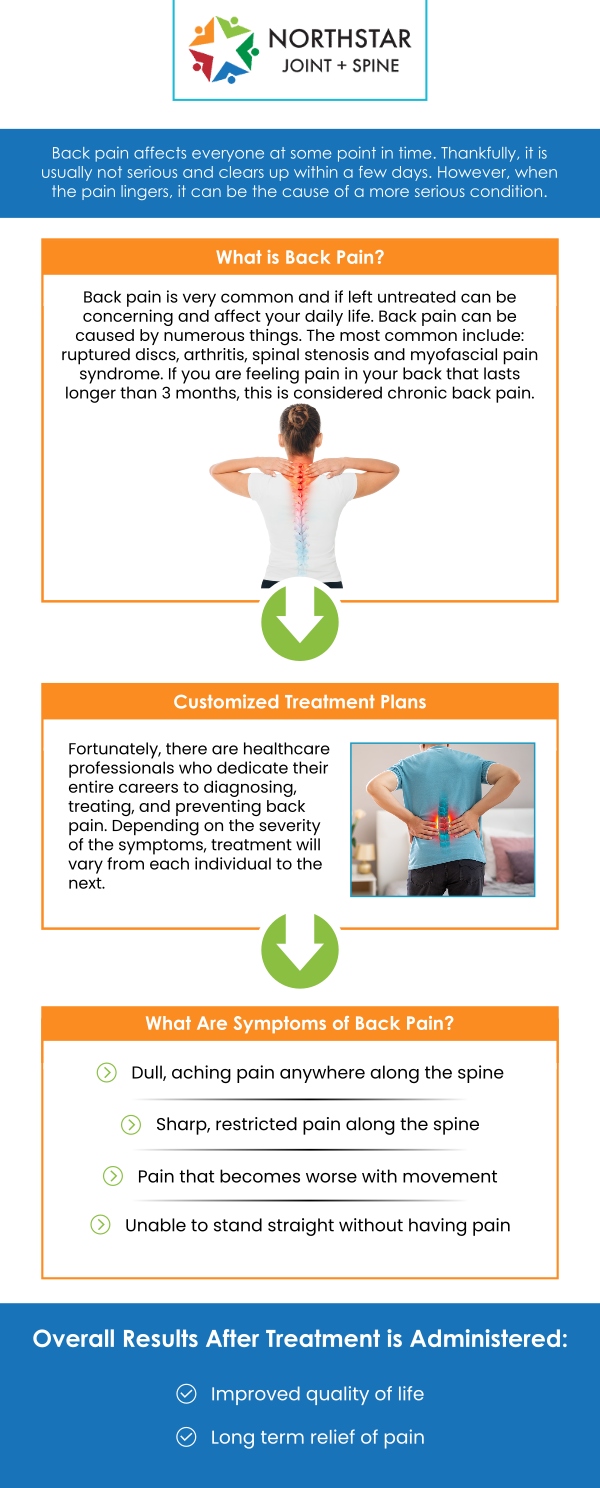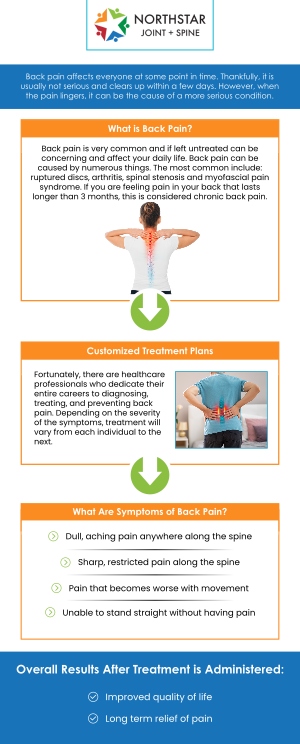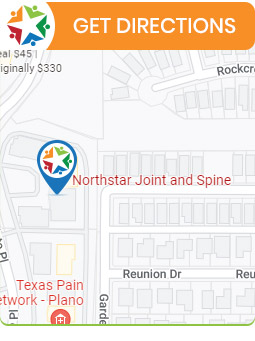Lower Back Pain Doctor in Plano, TX
Lower back pain is a common condition that can result from poor posture, muscle strain, or spinal issues such as herniated or degenerative discs. Symptoms may include stiffness, aching, or sharp pain that interferes with daily activities and overall quality of life. At Northstar Joint and Spine, Board Certified Dr. Robert J. Nocerini, MD, offers comprehensive evaluations to identify the root cause and develop a personalized treatment plan tailored to each patient’s needs. With a focus on relieving discomfort, restoring mobility, and preventing future flare-ups, Dr. Nocerini helps patients manage lower back pain effectively and return to an active lifestyle. For more information, contact us today or schedule an appointment online. We are conveniently located at 7704 San Jacinto Pl Suite #200 Plano, TX 75024.


Table of Contents:
What can be mistaken for lower back pain?
Can poor posture lead to lower back pain?
How long does lower back pain usually last?
When should I see a doctor for lower back pain?
What Makes Board-Certified Dr. Robert J. Nocerini, MD the Best Choice for Lower Back Pain Treatment at Northstar Joint and Spine in Plano, TX?
Several conditions can be associated with symptoms that feel like lower back pain, even when the source of the pain originates elsewhere. Muscle tension in the hips or glutes can radiate upward, leading individuals to believe the issue stems from the spine. Sacroiliac joint dysfunction, which occurs near the base of the spine, often presents with pain that closely resembles lower back discomfort and may be easily confused with it. Digestive concerns such as bloating or inflammation in the intestines may also cause abdominal pressure that spreads to the lower back region. Discomfort originating from the kidneys or reproductive system can also create a similar sensation in the same general area. When the discomfort is persistent or hard to localize, it becomes more difficult to determine where it’s actually coming from without a full evaluation.
Because of how many different systems overlap in that part of the body, it’s not uncommon for individuals to attribute pain to the back when another structure is involved. The specialists at Northstar Joint and Spine conduct a thorough physical assessment to better isolate the root cause and tailor treatment accordingly.
Poor posture is a common contributor to ongoing back discomfort, especially in individuals who spend extended periods seated or working in static positions. When the spine is not properly supported, muscles in the lower back must compensate by remaining engaged for longer than they’re built to. That constant low-level strain builds over time and can result in noticeable tension and fatigue in the lower lumbar region. Standing with uneven weight distribution, arching the back excessively, or leaning too far forward while walking can slowly impact the way the spine carries the body’s weight. When the pelvis begins to tilt forward or the natural curve of the spine becomes exaggerated, it places added stress on joints and discs. The result is a cycle of discomfort that often feels worse with activity and doesn’t fully go away with rest. Small corrections in everyday movement and targeted exercises can help realign the spine and support its natural function. Patients who visit Northstar Joint and Spine may be guided toward those subtle but impactful shifts that help reduce discomfort and improve long-term stability.
The timeline for lower back discomfort depends on a number of factors, including what’s causing it and how the body responds to movement, rest, and care. Mild cases related to overuse or stiffness often fade within a few days and may not require clinical intervention at all. Others may linger longer, especially if poor movement patterns or structural imbalances continue to reinforce the discomfort.
In cases where symptoms persist for several weeks or return regularly, further evaluation is often helpful. Chronic lower back pain does not always point to a serious issue, but it does suggest the body is under strain that needs to be addressed more directly. Discomfort that flares during activity or that wakes the individual from sleep can indicate an underlying imbalance worth exploring further.
For those dealing with lower back symptoms that don’t seem to resolve or that interfere with daily routines, seeking care from the pain specialists at Northstar Joint and Spine can help patients find symptom relief and long-term improvements.
Mild stiffness or occasional soreness in the lower back is relatively common and often improves with activity or stretching. However, if the discomfort continues for more than a few weeks or becomes progressively worse, it may signal that the body is dealing with something more persistent. Back pain that affects sleep, causes numbness, or radiates into the legs is another sign that further assessment is warranted.
Not all lower back issues require advanced treatment, but evaluation by a specialist can help clarify what’s contributing to the discomfort and offer a path toward more lasting relief. In some cases, the issue may be related to a structural imbalance or strain that can be addressed through non-invasive care. Identifying those patterns early can prevent them from becoming more disruptive over time. The team at Northstar Joint and Spine offers comprehensive diagnostics and care options for patients experiencing lower back pain that no longer responds to basic at-home approaches. When the discomfort becomes a consistent obstacle, seeking help is not just about relief; it’s about preventing long-term limitations in mobility and quality of life.
Board Certified Dr. Robert J. Nocerini, MD is a highly experienced pain management physician at Northstar Joint and Spine in Plano, TX. With 26 years of medical experience, Dr. Nocerini is dedicated to providing specialized care to patients suffering from chronic pain conditions, including lower back pain. His expertise in Pain Medicine, board-certified by the American Board of Medical Specialties, allows him to offer a comprehensive approach to pain management, tailored to each patient’s unique needs. Whether you’re dealing with sciatica, degenerative disc disease, or other back issues, Dr. Nocerini is committed to helping you achieve relief and improve your quality of life.
Dr. Nocerini’s extensive background in Pain Medicine allows him to employ a range of advanced techniques and treatments for pain relief. He provides both non-invasive options and minimally invasive procedures, such as spinal injections and nerve blocks, to treat chronic pain. By focusing on personalized treatment plans, Dr. Nocerini ensures that patients receive the most effective care for their specific condition. His dedication to improving patient outcomes has made him a trusted provider for those in need of expert care in Plano, TX.
Dr. Robert J. Nocerini, MD, is committed to providing compassionate, effective care for individuals suffering from chronic pain, including lower back pain. At Northstar Joint and Spine, his extensive experience and specialized expertise ensure that each patient receives the highest level of treatment tailored to their specific needs. If you’re struggling with chronic pain, Dr. Nocerini is here to help you regain control of your life and improve your overall well-being. Lower back pain treatment is available at Northstar Joint and Spine. For more information, contact us today or schedule an appointment online. We are conveniently located at 7704 San Jacinto Pl Suite #200 Plano, TX 75024. We serve patients from Plano TX, Willow Bend TX, Frisco TX, Allen TX, Addison TX, North Dallas TX, and surrounding areas.

Check Out Our 5 Star Reviews


Additional Services You May Need
▸ Back Pain
▸ Shoulder Pain
▸ Chronic Pain
▸ Epidural Steroid Injections
▸ Spinal Cord Stimulation
▸ Viscosupplementation
▸ Genicular Nerve Blocks
▸ Facet Injections
▸ Joint Injections
▸ Sacroiliac Joint Injections
▸ Lumbar and Cervical
▸ Facet Medial Branch Blocks
▸ Diagnostic Nerve Blocks
▸ Medication Management
▸ Neck Pain Doctor
▸ Diabetic Peripheral Neuropathy
▸ Headaches
▸ Suboxone
▸ Botox for Migraines
▸ Peripheral Nerve Stimulation
▸ Spine
▸ Joints
▸ Muscles
▸ Bones

Additional Services You May Need
▸ Back Pain
▸ Shoulder Pain
▸ Chronic Pain
▸ Epidural Steroid Injections
▸ Spinal Cord Stimulation
▸ Viscosupplementation
▸ Genicular Nerve Blocks
▸ Facet Injections
▸ Joint Injections
▸ Sacroiliac Joint Injections
▸ Lumbar and Cervical
▸ Facet Medial Branch Blocks
▸ Diagnostic Nerve Blocks
▸ Medication Management
▸ Neck Pain Doctor
▸ Diabetic Peripheral Neuropathy
▸ Headaches
▸ Suboxone
▸ Botox for Migraines
▸ Peripheral Nerve Stimulation
▸ Spine
▸ Joints
▸ Muscles
▸ Bones






